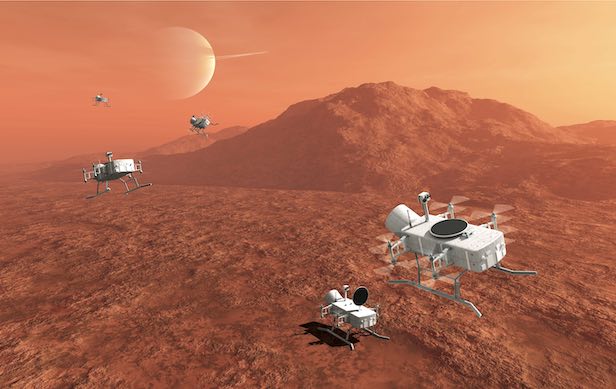Future Tech: Titan quadcopter
NASA’s innovative proposal to send a robotic dragonfly to scout Saturn’s largest moon

There isn’t enough solar energy available on Titan to power such an energy-intensive mission as Dragonfly, so it will use a Multi-Mission Radioisotope Thermoelectric Generator powered by plutonium. Image credit: Adrian Mann
One of NASA’s most impressive current projects is the Curiosity Mars rover. The 899-kilogram (1981-pound) nuclear-powered rover is a travelling laboratory, which was landed on the Red Planet’s surface by a rocket-powered sky crane in 2012. However, it is no simple matter to navigate a $2.5 billion rover on another world. As a result, Curiosity moves very cautiously, crawling along at up to 200 metres (656 feet) per day, travelling 17.81 kilometres (11.06 miles) as of sol 1891, which equates to around five Earth years. This inevitably limits the reach of such missions, and will be even more challenging on our next landing targets – the large moons of Jupiter and Saturn. The most interesting of these moons, Saturn’s Titan, offers a unique opportunity in the Solar System.
Titan is among one of the most Earth-like worlds in our Solar System; it may be cold, but like Earth, and unlike any other moon, it has a thick atmosphere and a rocky surface. In principle, you’d only need an oxygen mask and very warm clothes to survive. Titan’s atmosphere is mainly composed of nitrogen, creating an atmospheric pressure of almost 1.5 times greater than our planet. The surface density is four times greater but the surface gravity is only 1/7th of the Earth’s; this combination makes it much easier to perform aerodynamic flight. It is even theorised that human visitors might be able to fly with arm-mounted wings! Titan’s atmosphere is also what makes the moon such an important target for exploration: the temperature and pressure are such that a mixture of hydrocarbon liquid exists as water does on Earth. This forms lakes, seas, clouds and snow, if it’s cold enough. Simulations suggest Titan’s rainfall will consist of very large drops falling in slow motion!
As part of NASA’s New Frontiers program, this mission aims to exploit Titan’s aeronautical advantages by sending a dual-quadcopter drone.The Dragonfly lander has been proposed by The Johns Hopkins Applied Physics Laboratory in Maryland, and would be much like a traditional lander, but equipped with rotors on four arms. There’d be two coaxial rotors per arm (so it’s possibly actually an octocopter) to provide redundancy. Though flying sounds like it would be even more of a challenge, it is actually much simpler to accomplish autonomously than driving; the surface temperature is -290 degrees Fahrenheit (-180 degrees Celsius).
Solar energy is limited on Titan due to its atmospheric haze, so Dragonfly would be powered using a Multi-Mission Radioisotope Thermoelectric Generator (MMRTG) like Curiosity and Cassini. This converts heat, from the decay of plutonium-238, into electricity. In Dragonfly’s case, the MMRTG would recharge while landed, which would provide the bursts of power necessary for flight. In a single hour-long flight, Dragonfly could go further than any rovers have travelled before, flying for a few tens of kilometres, though most of its time would be spent on the ground taking data. Current plans propose making a flight once every Titan day, 16 Earth days, for up to two years, exploring areas hundreds of kilometres apart.
Dragonfly’s experiments would investigate the habitability of Titan’s environment, the progression of its prebiotic chemistry and evidence for hydrocarbon and water-based organisms. Not only does Titan have this Earth-like liquid cycle, but it is thought the chemical environment was similar to that of the earlier Earth. Now the Cassini mission has even determined that there appears to be a global ocean of salty water under a water ice crust, along with the hydrocarbon seas on top!
Keep up to date with the latest news in All About Space – available every month for just £4.99. Alternatively you can subscribe here for a fraction of the price!




